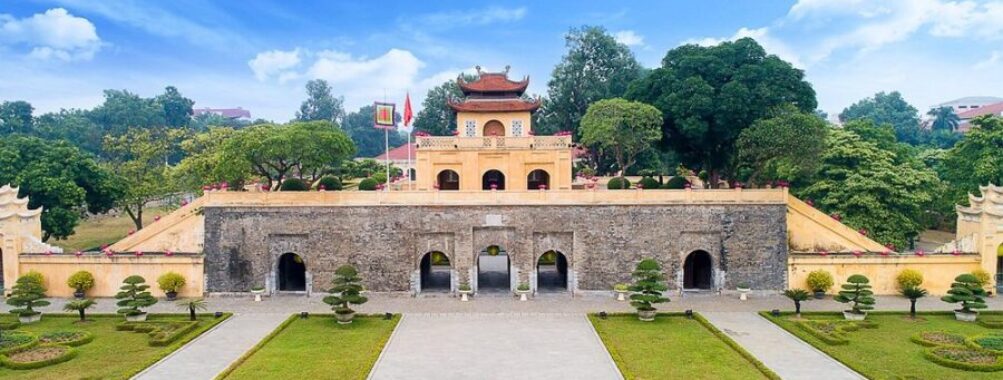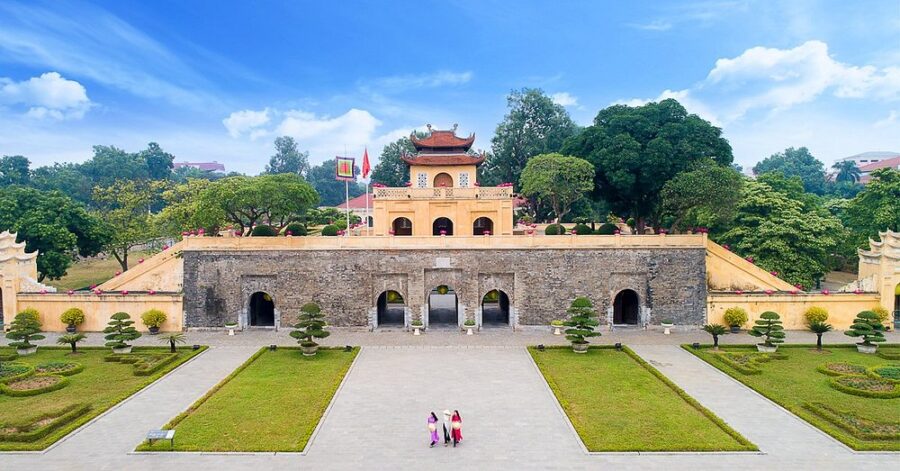
Imperial Citadel of Thang Long
Table of Contents
History and Significance

The Thang Long Imperial Citadel, also known as Hoang Thanh Thang Long, holds immense historical and cultural significance as a symbol of Vietnamese power and resilience. Constructed in the 11th century by the Ly Dynasty, the citadel was built upon the ancient citadel of Dai La. This imperial citadel of Thang Long served as the political center of the Dai Viet for over 13 centuries and the seat of power for successive Vietnamese dynasties. As a UNESCO World Heritage Site, the Thang Long citadel stands as a testament to the long and storied history of Vietnam. The citadel was built during the Lý Dynasty, marking the beginning of Thang Long as the capital city. The site at 18 Hoang Dieu has revealed layers of history through excavation, demonstrating the continuous use of the area for political and cultural purposes.
Main Attractions and Activities
Visiting the Imperial Citadel offers a unique opportunity to explore key sites. You’ll find several points of interest, including:
- The Hanoi Flag Tower, a powerful symbol of Hanoi.
- Kinh Thien Palace, offering insights into royal life.
The Doan Mon, or Main Gate, still stands, inviting you to step back in time. The central sector of the Imperial Citadel reveals the scale and ambition of this once-forbidden city. Don’t miss the 18 Hoang Dieu archaeological site, providing tangible links to the past through ongoing excavation. For military history buffs, there’s a fascinating connection to the Vietnam War era, as the citadel area once housed the Politburo and the Central Military Commission, and D67. The Hanoi People’s Committee organizes worthwhile night tours, too!
Visitor Experience
The visitor experience at the Thang Long Imperial Citadel is designed to immerse you in Vietnamese history. Walking through the central sector of the imperial citadel, you are tracing the steps of emperors and soldiers, and the echoes of their time resonate in every brick and stone. The vast expanse of the site allows you to appreciate the scale and grandeur of this former seat of power. The meticulous excavation work at the archaeological site at 18 Hoang Dieu provides tangible links to the past, offering glimpses into the lives of those who inhabited this space centuries ago. And seriously, you should make time to walk down Hoang Dieu Street. Visiting the imperial citadel is like stepping into a time capsule, allowing you to connect with Vietnam’s rich heritage on a deeply personal level. I remember bringing my family here, and even my picky teenage son was impressed, so you know it has something for everyone.
Tips for Visitors
To maximize your experience at the Thang Long Imperial Citadel, it is best to plan your visit carefully. There are a few key points to keep in mind for a successful visit:
- Wear comfortable shoes, as you’ll be doing a lot of walking around Hanoi’s ancient citadel.
- Consider visiting during the cooler months to avoid the intense heat and humidity, particularly if you’re not used to Vietnam’s climate.
- Start your exploration early in the morning to beat the crowds and take advantage of the quieter atmosphere.
- Don’t forget to bring water and sunscreen, as the site offers limited shade.
If you are a military history buff, a visit to the Vietnam Military History Museum is recommended, too. Allow ample time to explore the entire citadel; a thorough visit requires at least half a day to fully appreciate the historical significance of the central sector. And remember to check the schedule for any special events or exhibits that may be taking place during your visit, as the Hanoi People’s Committee often organizes cultural activities here!
Accessibility and Facilities
The Thang Long Imperial Citadel strives to be accessible to all visitors, though certain limitations exist due to the historical nature of the site. While some areas may present challenges for those with mobility issues, efforts have been made to improve accessibility where possible. The main gate and the central sector are mostly flat and navigable. However, some of the older structures may have uneven surfaces or steps. Restrooms are available on site, and the Hanoi People’s Committee has provided clear signage to help visitors navigate the area. The Thang Long Imperial Citadel is an important landmark for people with disabilities. Information in multiple languages is offered to cater to international tourists. Water fountains are available, and shaded resting areas are strategically placed throughout the site, so you can see Ho Chi Minh’s vision for the area. Additionally, guided tours are available, offering valuable insights into the history and significance of the UNESCO World Heritage Site.
Unique Features
The Thang Long Imperial Citadel sets itself apart through a variety of unique features that offer an unparalleled insight into Vietnamese history. One of the most striking aspects is the ongoing excavation at the archaeological site located at 18 Hoang Dieu, which continues to unearth artifacts and structures from various periods of the citadel’s history. This provides a living, breathing connection to the past, making it more than just a static monument. And what’s more, the layered architectural remains showcase the influence of successive dynasties, from the Ly to the Tran dynasties, each leaving its mark on the imperial citadel of Thang Long. The seamless integration of historical remnants with modern Hanoi further enhances its appeal. The Hanoi Flag Tower, still standing tall, symbolizes the resilience and strength of Vietnam, whilst acting as a reminder of Vietnam’s capital throughout all years of history.
Overall Impressions
My overall impression of the Thang Long Imperial Citadel is one of profound respect for the rich and complex history of Vietnam. Walking through the central sector of the imperial citadel, you can’t help but feel a deep connection to the Vietnamese people and their enduring spirit. The scale of the site at 18 Hoang Dieu is impressive, and the ongoing excavation work adds a sense of discovery and anticipation. It’s a place where the past and present converge, offering a unique perspective on Vietnam’s cultural heritage. The Hoang Thanh Thang Long provides a tangible link to the past, allowing you to appreciate the Thang Long citadel’s importance. I think the layout of the central sector allows for a thorough exploration of Hanoi’s ancient citadel, providing a fascinating journey through time, from the 11th-century Ly Dynasty to the Vietnam War. It makes you want to learn more about Vietnam’s military history!
Pros and Cons
Visiting the Thang Long Imperial Citadel has its advantages. Firstly, the Hanoi citadel offers an immersive historical experience that provides invaluable insights into Vietnamese history, from the 11th century to the modern era. The Thang Long citadel’s well-preserved structures and the ongoing excavation at the archaeological site provide a tangible connection to the past. The location in the heart of Hanoi makes it easily accessible, and the site provides a unique opportunity to delve into the country’s rich cultural heritage. However, potential drawbacks to consider include:
- The vastness of the central sector may require a significant time commitment to explore thoroughly.
- During peak tourist season, the site can become crowded, diminishing the sense of tranquility.
- Certain areas of the citadel may not be easily accessible to those with mobility issues due to the historical nature of the site.
Also, I think it could have better signage!
Location
Places to Stay Near Imperial Citadel of Thang Long
Find and Book a Tour
Explore More Travel Guides
No reviews found! Be the first to review!